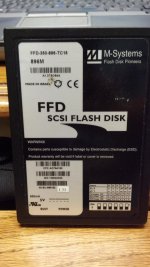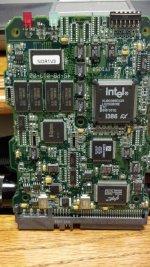IBM Portable PC
Veteran Member
I've been meaning to try SCSI Target mode for years and have finally had a brief but highly successful play i.e. setting up a PC (Pentium running PCDOS 7) to appear as a SCSI hard drive to any machine connected to it's SCSI port i.e. one computers SCSI port to another. The virtual drive, which is a RAM drive on the host, is currently limited to about 65MB. This of course is more than enough for many vintage machines. The RAM drive can of course be easily saved and reloaded and appears as a single fine on the host.
Look at:
https://www.google.com/webhp?sourceid=chrome-instant&ion=1&espv=2&ie=UTF-8#q="8xxtarg.zip"&safe=off
and you will easily find 8xxtarg.zip which contains the sample code that was released by Symbios Logic in the 90's. You may also like to download some product manuals for suitable Symbios Logic SCSI controller chips.
After setting up a PC with an appropriate Symbios Logic PCI based SCSI controller and ASPI driver, you simply run the 8xxtarg.exe. It asks for various options and then the PC appears on the SCSI bus as a hard drive. The simulated drive is in RAM on the PC and can be saved and loaded.
Symbios Logic supplied full source code in c and so now what I need, is for someone to make the required change/s to support 256 byte sectors (currently only; 512, 1024, 2048 and 4096 are supported) for use with and Acorn BBC Model B and perhaps another system or two. Adding a menu option to enable/disable SCSI parity would also be wonderful.
8xxtarg.exe appears quite stable, from another vintage PC I've been able to happily FDISK and FORMAT /S to my hearts content and can also verify that the saving and loading of the virtual drive works well. These can then be readily uploaded and shared.
Look at:
https://www.google.com/webhp?sourceid=chrome-instant&ion=1&espv=2&ie=UTF-8#q="8xxtarg.zip"&safe=off
and you will easily find 8xxtarg.zip which contains the sample code that was released by Symbios Logic in the 90's. You may also like to download some product manuals for suitable Symbios Logic SCSI controller chips.
After setting up a PC with an appropriate Symbios Logic PCI based SCSI controller and ASPI driver, you simply run the 8xxtarg.exe. It asks for various options and then the PC appears on the SCSI bus as a hard drive. The simulated drive is in RAM on the PC and can be saved and loaded.
Symbios Logic supplied full source code in c and so now what I need, is for someone to make the required change/s to support 256 byte sectors (currently only; 512, 1024, 2048 and 4096 are supported) for use with and Acorn BBC Model B and perhaps another system or two. Adding a menu option to enable/disable SCSI parity would also be wonderful.
8xxtarg.exe appears quite stable, from another vintage PC I've been able to happily FDISK and FORMAT /S to my hearts content and can also verify that the saving and loading of the virtual drive works well. These can then be readily uploaded and shared.
Last edited:





